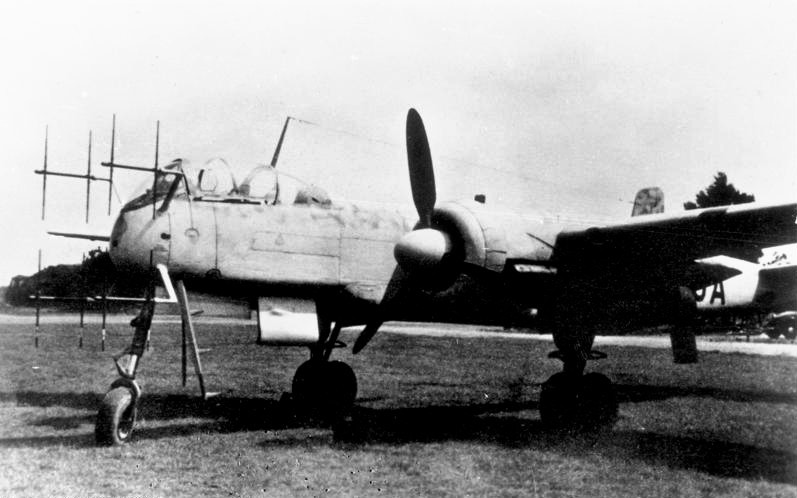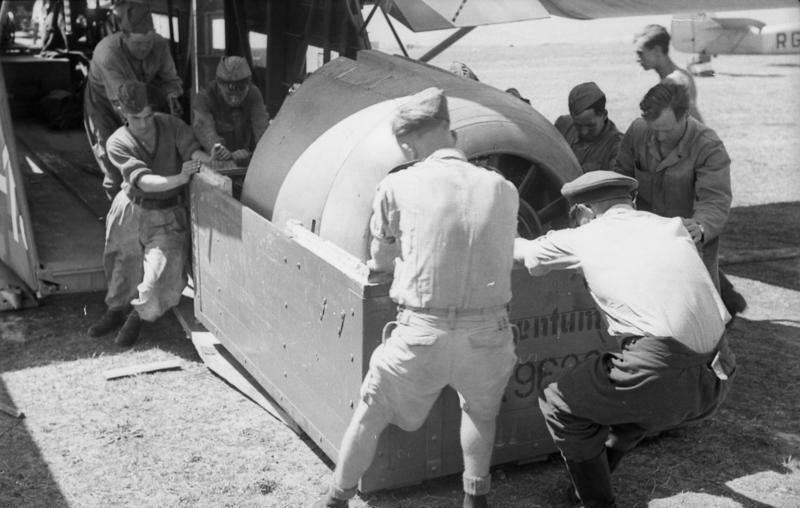|
Heinkel He 277
The Heinkel He 277 was a four-engine, long-range heavy bomber design, originating as a derivative of the He 177, intended for production and use by the German Luftwaffe during World War II. The main difference was in its engines. The He 177 used two Daimler-Benz DB 606 "power system" engines, each of which consisted of two combined Daimler-Benz DB 601 engines, each DB 606 weighed 1.5 tons. The He 177A-3 and its successors used two DB 610 "power system" engines, each of which consisted of two combined Daimler-Benz DB 605 engines, each DB 610 weighed 1.5 tons. Due to problems with both the DB 606 and the DB 610, the He 277 was intended to use four unitized BMW 801E 14-cylinder radial engines, each mounted in an individual nacelle and each turning a three-blade, four-meter diameter propeller. The design was never produced and no prototype airframe was completed.Griehl & Dressel 1998, p. 203 The deteriorating condition of the German aviation industry late in the war and the competit ... [...More Info...] [...Related Items...] OR: [Wikipedia] [Google] [Baidu] |
Heavy Bomber
Heavy bombers are bomber aircraft capable of delivering the largest payload of air-to-ground weaponry (usually bombs) and longest range (takeoff to landing) of their era. Archetypal heavy bombers have therefore usually been among the largest and most powerful military aircraft at any point in time. In the second half of the 20th century, heavy bombers were largely superseded by strategic bombers, which were often smaller in size, but had much longer ranges and were capable of delivering nuclear bombs. Because of advances in aircraft design and engineering — especially in powerplants and aerodynamics — the size of payloads carried by heavy bombers has increased at rates greater than increases in the size of their airframes. The largest bombers of World War I, the four engine aircraft built by the Sikorsky company in the Soviet Union, could carry a payload of up to of bombs. By the middle of World War II even a single-engine fighter-bomber could carry a bomb load, an ... [...More Info...] [...Related Items...] OR: [Wikipedia] [Google] [Baidu] |
Ernst Heinkel
Dr. Ernst Heinkel (24 January 1888 – 30 January 1958) was a German aircraft designer, manufacturer, '' Wehrwirtschaftsführer'' in Nazi Germany, and member of the Nazi party. His company Heinkel Flugzeugwerke produced the Heinkel He 178, the world's first turbojet-powered aircraft, and the Heinkel He 176, the first rocket aircraft. Early life Heinkel was born in Grunbach, today a part of Remshalden. As a young man he became an apprentice machinist at a foundry. Heinkel studied at the Technical Academy of Stuttgart,"Who's who in Nazi Germany" Robert S. Wistrich. Routledge, 2001. , . Retrieved March 16, 2010. where he initially became interested in aviation through a fascination with |
Heinkel He 219
The Heinkel He 219 ''Uhu'' ("Eagle-Owl") is a night fighter that served with the German Luftwaffe in the later stages of World War II. A relatively sophisticated design, the He 219 possessed a variety of innovations, including Lichtenstein SN-2 advanced VHF-band intercept radar, also used on the Ju 88G and Bf 110G night fighters. It was also the first operational military aircraft to be equipped with ejection seats and the first operational German World War II-era aircraft with tricycle landing gear. Had the ''Uhu'' been available in quantity, it might have had a significant effect on the strategic night bombing offensive of the Royal Air Force; however, only 294 of all models were built by the end of the war and these saw only limited service.Boyne 1997, p. 330. Ernst-Wilhelm Modrow was the leading night fighter ace on the He 219. Modrow was credited with 33 of his 34 night air victories on the type. Design and development Development and production of the He 219 was prot ... [...More Info...] [...Related Items...] OR: [Wikipedia] [Google] [Baidu] |
Schwechat
Schwechat () is a town southeast of Vienna known for the Vienna International Airport and Schwechater beer. The city is home to the refineries of the Austrian national oil company OMV. Geography Schwechat is named after the river Schwechat, which flows through the centre of town. The city subdivisions, called Katastralgemeinde ( Cadastre), are Kledering, Mannswörth, Rannersdorf and Schwechat. Population History Home to the settlement Ala Nova of the Roman Empire, the city was first mentioned in a document in 1334. The meeting at Schwechat of Emperor Leopold I with Jan Sobieski in 1683, after the liberation of Vienna, is commemorated by an obelisk. The imperial troops defeated the Hungarian insurgents in a battle fought here in October 1848. In 1724, a textile factory was established in Schwechat. Schwechat profited massively from the Austrian industrialisation wave of the 19th century, many of the companies established then still exist (i.e. the Dreher Brewery, fou ... [...More Info...] [...Related Items...] OR: [Wikipedia] [Google] [Baidu] |
List Of RLM Aircraft Designations
This is a list of aircraft type numbers allocated by an institution under the direction of ''Heereswaffenamt'' (before May 1933) and the Reich Air Ministry (RLM) between 1933 and 1945 for German German(s) may refer to: * Germany (of or related to) **Germania (historical use) * Germans, citizens of Germany, people of German ancestry, or native speakers of the German language ** For citizens of Germany, see also German nationality law **Ge ... military and civilian aircraft and in parallel to the list of German aircraft engines. See RLM aircraft designation system for an explanation of how these numbers were used. There is no single "master list" applicable all the way from 1933 to 1945 - numbers were occasionally duplicated, reallocated, or re-used. Sources differ on the allocations. Listing 0-100 101-200 201-300 301-400 401- See also * RLM numbering system for gliders and sailplanes * Japanese military aircraft designation systems Notes References *Heinz J ... [...More Info...] [...Related Items...] OR: [Wikipedia] [Google] [Baidu] |
Ernst Udet
Ernst Udet (26 April 1896 – 17 November 1941) was a German Reich, German pilot during World War I and a ''Luftwaffe'' Colonel-General (''Generaloberst'') during World War II. Udet joined the Deutsche Luftstreitkräfte, Imperial German Air Service at the age of 19, and eventually became a notable flying ace of World War I, scoring 62 confirmed victories by the end of his life. The highest scoring German fighter pilot to survive that war, and the second-highest scoring after Manfred von Richthofen, his commander in the Jagdgeschwader 1 (World War 1), Flying Circus, Udet rose to become a squadron commander under Richthofen, and later under Hermann Göring. Udet spent the 1920s and early 1930s as a stunt pilot, international Barnstorming, barnstormer, light aircraft manufacturer, and playboy (lifestyle), playboy. In 1933, Udet joined the Nazi Party and became involved in the early development of the ''Luftwaffe'', where he was appointed director of research and development. I ... [...More Info...] [...Related Items...] OR: [Wikipedia] [Google] [Baidu] |
Junkers Jumo 211
The Jumo 211 was a German inverted V-12 aircraft engine, Junkers Motoren's primary aircraft engine of World War II. It was the direct competitor to the Daimler-Benz DB 601 and closely paralleled its development. While the Daimler-Benz engine was mostly used in single-engined and twin-engined fighters, the Jumo engine was primarily used in bombers such as Junkers' own Ju 87 and Ju 88, and Heinkel's H-series examples of the Heinkel He 111 medium bomber. It was the most-produced German aero engine of the war, with almost 70,000 examples completed. Design and development The Jumo 211 was developed by Dr. Franz Josef Neugebauer as scaled-up successor to the earlier Jumo 210. The 210 was Germany's first modern aviation engine, with three valves per cylinder, a cast crankcase, and supercharger as standard. When it was designed in the early 1930s, its 700 PS design power was a relatively common power rating and many pre-war German designs were based around it. As it was further d ... [...More Info...] [...Related Items...] OR: [Wikipedia] [Google] [Baidu] |
Power-egg
A power-egg is a complete "unitized" modular engine installation, consisting of engine and all ancillary equipment, which can be swapped between suitably designed equipment, with standardised quick-changing attachment points and connectors. In aircraft so designed the power-egg is typically removed before mean time to failure is reached and a fresh one installed, the removed engine then being sent for maintenance. Spare power-eggs may be stored in sealed containers, to be opened when needed. The power-egg or ''Kraftei'' format was used in some German Second World War era aircraft, particularly for twin or multi-engined airframe designs. It existed in two differing formats – the initial ''Motoranlage'' format which used some specialized added components depending on what airframe it was meant for use on, and the ''Triebwerksanlage'' format, a more complete unitization format usually including exhaust and oil cooling systems. Applications Germany Inline and radial engines wer ... [...More Info...] [...Related Items...] OR: [Wikipedia] [Google] [Baidu] |
Edgar Petersen
__NOTOC__ Edgar Petersen (26 April 1904 – 10 June 1986) was a German bomber pilot in the Luftwaffe during World War II and recipient of the Knight's Cross of the Iron Cross of Nazi Germany. Biography Petersen was instrumental, as '' Geschwaderkommodore'' of the Kampfgeschwader 40, in converting the Focke-Wulf Fw 200 into what Winston Churchill called the "Scourge of the Atlantic" during the Battle of the Atlantic. Petersen also served in the position of ''Kommandeur der Erprobungstellen'' (commander of all Luftwaffe test stations) as an ''Oberst'' later in the war, in which capacity from September 1942 onwards became centrally involved with the further development work required for the Luftwaffe's only operational heavy bomber, the Heinkel He 177 A, to make it combat ready, mostly focusing on the fire-prone DB 606 and DB 610 powerplants used for powering the He 177 A's airframe. In September 1942 ''Reichsmarschall'' Hermann Göring had rescinded the 1937-imposed mandate for th ... [...More Info...] [...Related Items...] OR: [Wikipedia] [Google] [Baidu] |
Oberst
''Oberst'' () is a senior field officer rank in several German-speaking and Scandinavian countries, equivalent to colonel. It is currently used by both the ground and air forces of Austria, Germany, Switzerland, Denmark, and Norway. The Swedish rank ''överste'' is a direct translation, as are the Finnish rank ''eversti'' and the Icelandic rank ''ofursti''. History and origins is a German word. Spelled with a capital O, "" is a noun and defines the military rank of colonel or group captain. Spelled with a lower case o, or "", it is an adjective, meaning "top, topmost, uppermost, highest, chief, head, first, principal, or supreme". Both usages derive from the superlative of , "the upper" or "the uppermost". As a family name, ''Oberst'' is common in the southwest of Germany, in the area known as the Black Forest ('' Schwarzwald''). The name is also concentrated in the north-central cantons of Switzerland (Aargau & Zürich). Here the Swiss version of ''Oberst'' is spelled ''Obri ... [...More Info...] [...Related Items...] OR: [Wikipedia] [Google] [Baidu] |
Bundesarchiv Bild 183-B19957, Edgar Petersen
The German Federal Archives or Bundesarchiv (BArch) (german: Bundesarchiv) are the National Archives of Germany. They were established at the current location in Koblenz in 1952. They are subordinated to the Federal Commissioner for Culture and the Media (Claudia Roth since 2021) under the German Chancellery, and before 1998, to the Federal Ministry of the Interior (Germany), Federal Ministry of the Interior. On 6 December 2008, the Archives donated 100,000 photos to the public, by making them accessible via Wikimedia Commons. History The federal archive for institutions and authorities in Germany, the first precursor to the present-day Federal Archives, was established in Potsdam, Brandenburg in 1919, a later date than in other European countries. This national archive documented German government dating from the founding of the North German Confederation in 1867. It also included material from the older German Confederation and the Imperial Chamber Court. The oldest documents i ... [...More Info...] [...Related Items...] OR: [Wikipedia] [Google] [Baidu] |






